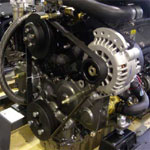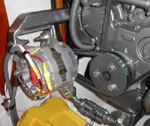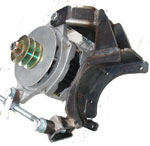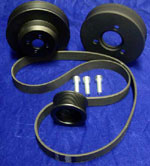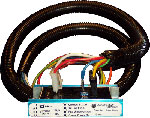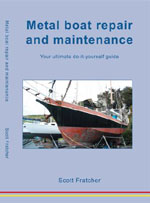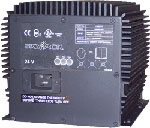 |
|
|
|||||||||||
|
How to use an AC/DC clampampor marine trouble shooting with an AC/DC clamp amp
By: Scott Fratcher - Marine Engineer/Captain Super tools can tell us much more about a yacht’s condition than a simple number. Super tools pay for themselves by saving time, effort and money. A super tool might tell us why our engine is overheating, or show where electrical connections have built up internal resistance along with other important information. In this article we discuss the use of an AC/DC clamp amp. A real “super tool”.
Clamp amp or Amp clampA clamp amp is an amazing tool that uses the Hall effect to measure the total amperage flow inside a closed wire. No need to cut or disconnect the wire to see what is going on inside. Just put the clamp amp jaws around any wire, or wires, or pipe, or any other conductive material and get a reading accurate to a tenth of an amp. If you clamp the positive lead feeding a ten-amp light the meter should show ten amps. If you clamp the positive and negative leads at the same time the meter should read zero (ten amps going each way equals a total of zero.) This can be very useful in tracking down the damaging effects of stray current or predicting how much life is left in an electrical device. For example we can set our meter to AC and clamp the boats power cord. We should expect a reading of zero. If we were to see a reading of an amp we would know we were “leaking” an amp of electricity somewhere. We can now clamp the power cords of all surrounding boats to know if they have an electrical leak that could cause damage to our vessel. We don’t even have to touch the surrounding boats, just simply clamp around the power cord and we have quick check if our boat is in danger. Here are some more quick tips for using a clamp amp:DC current comes from the boats battery system and AC tells the technician to start looking at the shore power— Keep switching and testing between AC and DC. AC might also come from bad diodes in the alternator, dirty current from battery chargers, leaking AC appliances, or power cord leaks. AC found in the DC system causes premature battery failure, errant noise in the radios, and electrical board failure— Note whether the meter is reading positive or negative. This tells us what direction the current is flowing-Use a clamp amp on the output lead of an alternator to check amperage. If one third of the output is shown as AC, and two-thirds DC then the alternator has a bad diode.— Clamp the output lead of the alternator with the engine off. Any amperage shows a shorted diode-Turn on every mast accessory (eg; mast head light, anchor light, spreader lights, etc…) at the same time. Clamp every piece of rigging individually. About 20% of the time I find a mast accessory leaking amperage to ground through the mast, down the rigging, and finally into the bonding system causing corrosion damage along the way— Add up all the amperages in the positive leads at the base of the mast then compare that to (the normally) single mast ground lead. If they are not equal then search out the errant power.— Clamp the prop shaft both AC and DC to check for stray current passing through the propeller, entering (or leaving) the water and back into the ground system through a zinc or other metal fitting- Clamp the SSB or ham radio ground plane copper strap on the back of the SSB radio. Hold the stop button of the main engine then turn the engine over for ten seconds (without starting) and check for current following the ground lead back to the main engine. (I have found over 50 amps at times. This is why SSB radios have a fuse on both the positive and negative leads)-Clamp whole wire bundles or duplex wires. They should all show zero. If there is an electrical leak then you will show an amp reading.— Check positive and negative amperage at the battery. They should be the same. If they are not equal you know to begin searching for the lost, boat destroying electrical leak— With every electrical device turned off, clamp the positive lead of the battery. It should show zero. So should the negative lead. If not there is an electrical leak. - Hold the stop button or pull the stop cable of an engine and clamp the main starter cable. Turn the engine over for ten seconds. Note the amperage the starter is drawing. Multiply the voltage by the amperage reading and compare that to the wattage listed for the starter. Drawing more wattage tells the technician the starter winding is beginning to fail giving pre-warning to the day when you push the start button and nothing happens- Clamp the solenoid energizing lead on the starter. It should read about four amps. A greater reading tells the technician the solenoid is on the way to failing- Allow the batteries to discharge on the yacht then start the engine. The alternator should begin charging at full power. Follow the charge lead all the way to the battery on both the positive and negative alternator lead. As you work you way toward the battery look for drops in amperage. The amperage has to be going somewhere. If you pass a battery cable connection and loose an amp this could indicate a leak or more importantly a dangerous hot spot building.- A long slow continuous loss of amperage may indicate too small a cable or a long area of corrosion hiding inside the insulation. This could indicate a cable that will heat and possibly burn if used at continuous duty for a long period of time, like attempting a fast recharge with a high output alternator after a deep discharge.- Clamp the alternator field wire. It should be about four amps for a typical marine high output alternator at full load.- During full alternator charge clamp each battery in a bank individually. Different values give an indication if a battery is failing-Test the capacity of a battery by using the clamp amp to set a load of twenty amps. Monitor the battery voltage till it drops out below 11. Multiply the hours the load held voltage by the amp load (20 is the typical testing standard) to give amp hour capacity of the battery. This number will tell the true capacity a battery is capable of. This gives the owner valuable information if it’s time to change batteries.- Clamp the leads feeding an electric windlass and activate the motor. Any lost current must be found-When at anchor clamp the anchor chain. Of course we should read zero, but we don’t always. Momentarily activate the windlass control and verify the chain still is not passing current. If the chain shows current it is probably leaking from the windlass, through the chain, into the water and into the metal hull or boat’s bonding system-If the vessel has a bonding system connecting through hulls, zincs and other under water fittings turn on every electrical device. Clamp the green bonding cable between every fitting. It is always amazing to me how many times we find stray current passing in the bonding system. On large battery banks use the clamp amp during recharge to check each jumper cable between batteries for amp distribution during charge. The amps to each battery should be about equel. One low or high amp draw to a battery could mean a bad battery. After a charging cycle use the clamp amp to check the jumper leads between batteries for a battery discharging into another indicating a shorted cell that is draining the rest of the bank.
How make a clamp mesure micro ampsIf one is expecting or needing to measure very small currents, one can wrap the wire-to-be-current-measured, if possible, around one of the jaws 10 times. This will increase the reading by 10. So a hundredth of an amp flow will read as a tenth of an amp on meter ect. Thanks to "Wire Weasel" for the tip.
Bizarre clamp amp findsThe strangest electrical path I ever found was on a 50 foot yacht about to head offshore. Fifteen amps of alternator negative charge was flowing up the steel engine throttle control cable to the aluminum helm pedestal where it crossed into the copper hydraulic steering control tubes. As we traced this strange path we found an area where the copper steering tube laid against the hull and touched a rigging chain plate bolt. The tube was pitted through almost to the point of leaking. The current went down the chain plate into the boats bonding system where it transferred into the SSB radio ground plane, into the SSB radio and through the SSB negative lead and finally back to the battery. On the same yacht we found a two amp leak where wires ran inside a stainless handrail. A tang had been welded onto the handrail that melted the interior wires and left a leak to ground. We found the stray current by clamping the handrail tube, the invisible leak inside clearly showed on the clamp amp. The amazed yacht owner had never even suspected he had an electrical problem. With the use of this “super tool” we identified, isolated and repaired these long term problems in a matter of a few hours. Other tips-From JethroHere is another technique to disprove the battery myth that one large battery of a certain charge state will adversely affect a smaller size battery of a different charge state while the two are connected together and the generator is running. Start with a standalone small battery that is fully charged. Clamp the lead going to it with the generator running and you will see that maybe just an amp or so is fed to the battery. While observing the amps going to the small battery, connect a large battery of low charge state in parallel with the small battery. The amps to the small battery will remain the same. Clamp a wire going to the large battery and you will see that current is flowing to it. Each battery is getting whatever current that it needs. The larger, lesser charged battery is not going to affect the smaller fully charged battery in any way.
From WinglessOnce a friend called me over to complain about his electrical bill. I opened the panel and went down each line until I found a draw, we shut off everything but the 'fridge. I traced the wires and found it powered his roof heaters, resistor wires that prevent frost dams on a poorly insulated roof from damaging the roof. He had run that through the spring, summer and the winter was approaching, when he might need them, but we shut it off anyway.
|
||||||||||
| © Team Yachtwork 2007 | |||||||||||
